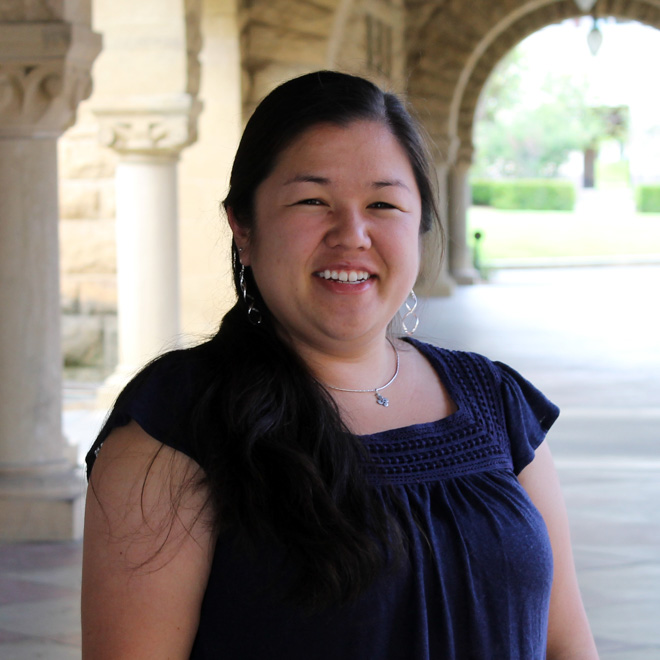
In this edition of Glam Grads, The Stanford Daily sat down with Gennifer Smith M.S ’15, a fifth-year Ph.D. candidate in Electrical Engineering (EE) who works in Assistant Professor of Electrical Engineering Audrey Bowden’s lab. Smith is working to develop a reliable, low-cost urinalysis test that can be used in low-resource settings and at home. Smith shared her path to creating medical devices, her design approach and her future plans.
The Stanford Daily (TSD): What got you interested in EE?
Gennifer Smith (GS): My brother was EE when I first started college, so it seemed like a natural path. But I thought I might want to be a doctor. So, I double-majored in EE and biology, so I had all of the prerequisites if I wanted to go to med school afterwards. I got an internship at Sandia National Labs, and there I started working on a low-cost tuberculosis (TB) device, and it was fascinating and great. It sparked my interest in engineering, which made me pursue engineering farther and come to grad school to do similar stuff. I had a Stanford scholarship for the first year and then I had National Science Foundation (NSF) funding for the next three years, [but] then I was out of funding, so I applied for a bunch of fellowships and I got the Achieving Rewards for College Scientists (ARCS).
TSD: Why are you interested in the medical side of engineering?
GS: My mom went through a lot of health issues when I was younger, so I’ve always had this desire to improve health. I watched her go through doctor after doctor and not figure out what was wrong … I was supposed to learn how to give my mom an IV, and I fainted. That’s when I decided that [a] medical [future] was not for me. [It] made me want to pursue doing medicine and health from the other side.
TSD: How did you become involved with low-cost medicine?
GS: After freshman year in college, I started working at Sandia National Labs in the Fire Safety Department, which actually has nothing to do with health. After that year, I got into the Biosensors and Nanomaterials Group. The person I was working for was working on a low-cost TB detection device both to detect TB and to predict antibiotic resistance; that was my first real exposure to working on a health project, and I loved it. It was a really impactful experience and TB is really a huge issue, especially in terms of antibiotic resistance. I was able to see the power of taking EE and solving health problems not only here in the First World but also solving health problems in a low-resource setting. It was really that TB project that got me interested in doing more low-cost medical diagnostics. I took a roundabout path in grad school, but now I’m coming back to it. The ones I work on now are urinalysis. The biggest issue I work on is with women’s health and urinary tract infections (UTIs). One of my friends has chronic UTIs and [goes] into the clinic to get diagnosed, so the whole point of the project now is to do that stuff at home or even in low-resource settings.
TSD: How does low-cost engineering differ from normal design?
GS: It takes a little bit more creativity. You’re trying to accomplish things that [are] accomplished in the clinic with a $10,000 machine, and you’re trying to make something on par with that for one or two dollars. To do that, you have to grab knowledge from a whole bunch of different areas. I work on optics, but most of the work is really on the materials and manufacturing cost. In order to do low-cost, you have to be … versatile with your knowledge base in order to make something that works.
TSD: What was your approach to designing your device?
GS: It started off with identifying the problem – UTIs. They are these dipsticks with little pads that change color based on what is in your urine. The problem is that if someone tries to do it at home, there is a lot of user error associated with it. So, if I go to the doctor and tell them the results of my dipstick, they will run the dipstick again. Our initial project was to take out that user error, so we made a nice box and manifold so people can do it at home or in low-resource situations … Now, we’re focused on taking that urinalysis test and adding functionality, which requires more of the design process and engineering to figure out how to do these things on a small scale. It is not just about building the device, but designing more of it.
TSD: What are your plans after you complete your project?
GS: I want to continue doing low-cost postdoc; I don’t know if it will be specifically urinalysis. Most of us on the project are invested in building a prototype, but none of us are super interested in starting a business with it. We’re hoping that someone will be interested enough in the product to take it and run. We have all of the protections and patents in order to commercialize it; it is just not my desire. It would be really cool to see [something] I designed come to fruition somewhere. I’d like to continue working on low-cost and eventually get a professorship somewhere.
Contact Josh Wagner at jwagner4 ‘at’ stanford.edu.
